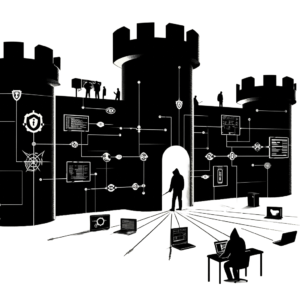Understanding Desktop Application Pentesting

Desktop application penetration testing is a crucial aspect of securing your business applications from potential cyber threats. By conducting thorough penetration testing on your desktop applications, you can identify and address vulnerabilities that could be exploited by malicious actors.
One major advantage of testing desktop applications is being able to mimic actual cyber attacks. This helps you see how secure your application is and how well it can withstand different types of threats. By taking this preventative approach, you can improve your security measures and protect important data from being accessed by unauthorized users.
Through comprehensive testing methodologies and tools, such as fuzzing and code review, desktop application penetration testing helps uncover security weaknesses that may have otherwise gone unnoticed. By addressing these vulnerabilities promptly, you can prevent potential data breaches and financial losses.
In simple terms, it’s really important to invest in checking the security of your desktop applications. This helps make sure your business apps are safe from cyber attacks. By doing this, you can keep your company’s good reputation and show your customers they can trust you.
Why Desktop Application Security Matters
Desktop application security is crucial for safeguarding your business applications and protecting sensitive data from cyber threats. In today’s digital age, where desktop applications are extensively used for various business operations, ensuring their security is paramount. Desktop application pentesting plays a vital role in identifying vulnerabilities and weaknesses in your business applications before malicious actors exploit them.
By testing your computer programs thoroughly for security vulnerabilities, you can find and fix problems before hackers can exploit them. This helps protect sensitive information, prevent costly breaches, and meet security standards. It also builds trust with customers, partners, and investors. The information learned from these tests can improve your organization’s security measures and keep you safe from new cyber threats.
By investing in desktop application security, you are not only protecting important business information but also promoting a culture of awareness around cybersecurity among your employees. This shows that you are dedicated to keeping sensitive data safe and ensuring that your business can continue running smoothly. Making desktop application security a priority is a wise choice that can help protect your business from cyber attacks and keep things running smoothly.
Penetration Testing Methodologies
Black Box Testing
Black Box Testing is a crucial technique in the realm of desktop application pentesting that helps secure your business applications from potential vulnerabilities and threats. This method focuses on testing the application externally, simulating attacks from an outsider’s perspective to identify weaknesses that malicious actors could exploit.
Through Black Box Testing, cybersecurity experts can discover security weaknesses in desktop applications like flaws in handling user input, storing data insecurely, or managing user sessions improperly. This proactive strategy helps companies fix these issues before hackers can exploit them.
Furthermore, Black Box Testing enhances the overall security of business applications by providing a comprehensive assessment of potential attack vectors and entry points. By conducting thorough testing and analysis, organizations can fortify their defenses, mitigate risks, and safeguard sensitive data from unauthorized access.
White Box Testing
White box testing, also known as clear box testing, is a method used to check the inside of a desktop application to find any potential security issues. By looking closely at the code, design, and layout of the application, white box testing can uncover weaknesses that hackers might use. It’s an important step in making sure your business applications are secure, as it helps pinpoint any vulnerabilities in the software.
Desktop application pentesting, which involves conducting penetration testing on business applications that run on desktop platforms, plays a vital role in securing your organization’s sensitive data and information. By simulating real-world cyber attacks, pentesting helps uncover security gaps and weaknesses in the application’s defenses. Through meticulous testing and analysis, cybersecurity professionals can recommend and implement robust security measures to mitigate potential risks and safeguard your business applications from cyber threats.
Learn more about the differences between testing methodologies in a separate blog post here.
Securing Business Applications Through Testing
Identification of Vulnerabilities
When it comes to securing your business applications, desktop application pentesting plays a crucial role in identifying vulnerabilities that could potentially compromise your organization’s sensitive data and operations. By conducting thorough penetration testing on your desktop applications, you can proactively detect weaknesses in your software before malicious hackers exploit them.
In pentesting, cybersecurity experts pretend to be hackers to find weaknesses in a system like settings that aren’t secure, problems with how passwords are checked, errors with how information is checked, and more. This detailed look helps us see where attackers could get in and lets us add strong security measures to keep our information safe.
By prioritizing the identification of vulnerabilities through desktop application pentesting, you can enhance your overall cybersecurity posture and safeguard your business applications from potential threats. Investing in regular pentesting not only protects your sensitive information but also helps in maintaining customer trust and compliance with data protection regulations.
Preventing Security Breaches
In today’s digital landscape, the threat of security breaches looms large, especially for businesses relying on desktop applications to streamline their operations. Desktop application pentesting is a crucial component in securing your business applications and safeguarding sensitive data from cyber threats. By conducting thorough pentesting procedures, vulnerabilities within the application can be identified and mitigated before malicious actors have the chance to exploit them.
Desktop application pentesting is like a security checkup for your computer programs. It helps discover where the weak points are that hackers could exploit. This proactive testing helps businesses improve their security measures and stay safe from potential threats. By following the recommendations from a security assessment, businesses can better protect their desktop applications from unauthorized access, data breaches, and other risks.
When you invest in desktop application pentesting, you’re not just checking off a box to meet some regulations. You’re actually safeguarding your business, your customers, and your reputation. By focusing on security through pentesting, you can lower the chances of security breaches and make sure your business applications can handle new cyber threats.
Embedding Desktop Application Pentesting in Business Culture
In today’s world of technology, it’s really important to make sure that your business applications are safe and secure to protect your customers’ information and keep their trust. One way to do this is by doing desktop application penetration testing. This means finding and fixing any weaknesses in your desktop applications before hackers can use them to access your data. By doing this, you can reduce the chances of any risks and make sure that your security is strong.
Checking the security of computer programs helps companies find and fix any potential problems that could make their systems vulnerable to cyber attacks. By doing this regularly, businesses can make sure their information stays safe.
Furthermore, it is important to create a culture of security awareness within your company to keep your information safe. By urging employees to make security a priority, stay up-to-date on potential threats, and follow recommended protocols, you can greatly lower the chances of experiencing a security breach.
By testing the security of your computer programs and promoting a mindset of being alert and following rules, you can protect your business programs and important information from cyber attacks.
Desktop application pentesting is a crucial aspect of securing your business applications and protecting sensitive data from cyber threats. By conducting thorough penetration testing on your desktop applications, you can identify and mitigate vulnerabilities that may be exploited by malicious actors, thereby enhancing the overall security posture of your organization.
In pentesting, cybersecurity experts pretend to be hackers to test the security of your computer programs. They look for weaknesses in the code, settings, or design that could be exploited by real hackers. By finding and fixing these problems before a cyberattack happens, you can protect your data, money, and reputation from being compromised.
In addition, testing the security of desktop applications is very important to make sure your organization follows industry rules and standards about keeping data safe. By regularly testing for security vulnerabilities, your organization can show that it takes security seriously. This will help build trust with customers, partners, and regulators.
In conclusion, it’s important to invest in testing your desktop applications to keep them secure from cyber threats. By being proactive and staying aware of potential risks, you can protect your business and assets from security breaches.
